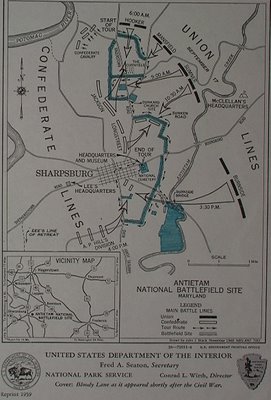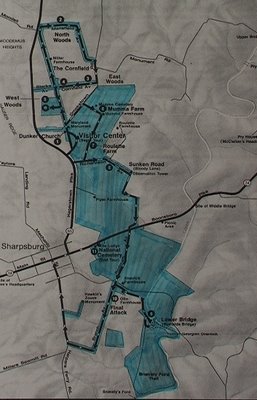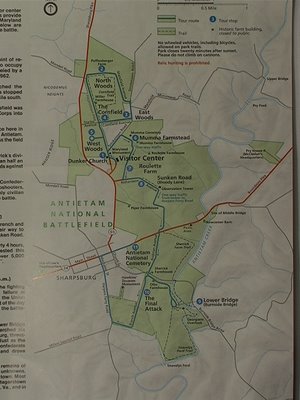 Seems that more often than not, what we read about the current state of battlefield preservation is one set of threats after another. The cliche headline invariably reads "Developers and preservationists engage in the second battle of (insert name here)". The pressure of constructing more bedrooms for Washington D.C. commuters, the current passion for enormous single-family homes, and the rapacious bulldozing by unscrupulous developers all continue to threaten America's most significant battlegrounds.
Seems that more often than not, what we read about the current state of battlefield preservation is one set of threats after another. The cliche headline invariably reads "Developers and preservationists engage in the second battle of (insert name here)". The pressure of constructing more bedrooms for Washington D.C. commuters, the current passion for enormous single-family homes, and the rapacious bulldozing by unscrupulous developers all continue to threaten America's most significant battlegrounds.For some good news, reflect upon the quiet and steady growth of the jewel in the crown of the National Park Service: Antietam National Battlefield.
I recently unpacked (we've just moved) the Antietam brochures that I've been collecting since I first visited the battlefield with my father in 1968. A comparison of one to the next, to the next, is both instructive and very encouraging.

This brochure was recently given to me by someone a little older than me. The map of 1948 (reprinted in 1959) depicts a park not much larger than the original authorization of 40 acres, including the National Cemetery. Originally the park consisted merely of the cemetery and the right-of-way along the battlefield road (in blue). This tiny footprint was later slightly enlarged to include the fields south of Burnside's Bridge. Note that the Hagerstown Pike still zoomed right through the heart of the Dunker Church/Cornfield area. Burnside's Bridge was still open to vehicular traffic at this time and the bypass around the bridge did not yet exist. The Cemetery lodge still served as headquarters, museum, and visitor's center. This was the period when the Dunker Church rose again, in its original location, with much original material, just in time for the Civil War Centennial.

The tiny, blue brochure of 1972 (revised 1975), an abbreviated, three-color cheepie reflecting our federal financial burden in Southeast Asia.
But what remarkable changes have occurred; The highway bypass now routes Hagerstown-bound traffic around, rather than through, the park. Similarly, motorists no longer cruised over Burnside's Bridge; a bypass was built to skirt it.
Note the still-skeletal nature of the areas around the Cornfield and Branch Avenue. Otherwise quite a lot of acreage had been added including the Mumma, Piper, and Sherrick farms. By this time the beautiful (and current) "Mission 66" visitor's center had been built. Other visitor amenities included the picnic area near Philly park and a nature trail.
No sign yet of the Pry House.
 Another cost-cutter; the blue (later red) brochure of the 1980s. This fairly muddy map premiers the tour route in use today with stops 1 through 11 just as visitors still encounter them.
Another cost-cutter; the blue (later red) brochure of the 1980s. This fairly muddy map premiers the tour route in use today with stops 1 through 11 just as visitors still encounter them.The Cornfield and Branch Avenue retained their War Department-days appearance but The Otto House, Pry House, and Roulette Farm had been acquired. The former nature trail evolved into the Snavely Ford Trail.
 The Park welcomed the Poffenberger farmstead with this 1995 map. And look at the growth! The battlefield now extends across the 65 to the base of Hauser Ridge. The North Woods is included in the footprint and the West Woods is finally, and securely in Federal hands (get it?). Also note the incremental growth of the Pry house holding. This characterizes the beginning of the "boom time" battlefield expansion.
The Park welcomed the Poffenberger farmstead with this 1995 map. And look at the growth! The battlefield now extends across the 65 to the base of Hauser Ridge. The North Woods is included in the footprint and the West Woods is finally, and securely in Federal hands (get it?). Also note the incremental growth of the Pry house holding. This characterizes the beginning of the "boom time" battlefield expansion. The 2003 map sees the addition of the fields to the east of the Sunken Road a huge tract extending to Antietam Creek, just as the Pry House acreage now extends westward to the creek.
The 2003 map sees the addition of the fields to the east of the Sunken Road a huge tract extending to Antietam Creek, just as the Pry House acreage now extends westward to the creek.The Sherrick Farm Trail has been established and land is acquired along Mondell Road nearly to the base of Nicodemus Heights.
 Now comes my year (the one of living rangerously). The current map is the 2004 printing. Note the welcome addition of the Cornfield trail.
Now comes my year (the one of living rangerously). The current map is the 2004 printing. Note the welcome addition of the Cornfield trail. In 140 years the park has grown from a meager 40 acres to just over 3,000 acres today, and not at the expense of the park's good relations with the surrounding community. The people of Sharpsburg have long embraced the significance of the battlefield. Area farmers have always been agreeable to selling out to the park when they retire from tilling the fields. Many their children still plant and harvest those fields under a very mutually beneficial leasing agreement with the Park.
How ironic that the scene of America's greatest calamity 144 years ago is now such a peaceful and agreeable place, with so many diverse people and interests working toward the same preservation goal.
 Hey!...wait a minute...this brochure's not out yet. O.K. just a peek at the new brochure, note the new Final Attack trail. What's more, come April of 2007 three more new trails are slated to open.
Hey!...wait a minute...this brochure's not out yet. O.K. just a peek at the new brochure, note the new Final Attack trail. What's more, come April of 2007 three more new trails are slated to open.In the Antietam Creek Valley lots of good people and organizations are working together, every day, to preserve this battlefield and the memories of those who sacrificed so much for all of us.
Sometimes, growth is good.
Come visit (and save your brochure).
Ranger Mannie
2 comments:
Are the colors on the 2007 map really that muted? I actually prefer the current map.
Muted colors are the results of me simply tacking maps to the wall in my basement, turning on a gooseneck lamp, and taking a pic.
mannie
Post a Comment